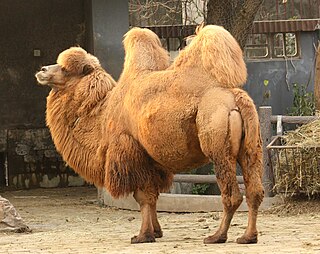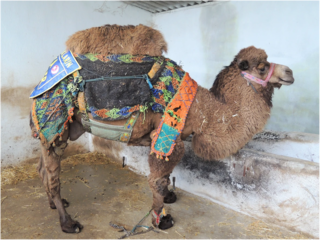
A camel is an even-toed ungulate in the genus Camelus that bears distinctive fatty deposits known as "humps" on its back. Camels have long been domesticated and, as livestock, they provide food and textiles. Camels are working animals especially suited to their desert habitat and are a vital means of transport for passengers and cargo. There are three surviving species of camel. The one-humped dromedary makes up 94% of the world's camel population, and the two-humped Bactrian camel makes up 6%. The wild Bactrian camel is a separate species and is now critically endangered.

The llama is a domesticated South American camelid, widely used as a meat and pack animal by Andean cultures since the pre-Columbian era.

Camelids are members of the biological family Camelidae, the only currently living family in the suborder Tylopoda. The seven extant members of this group are: dromedary camels, Bactrian camels, wild Bactrian camels, llamas, alpacas, vicuñas, and guanacos. Camelids are even-toed ungulates classified in the order Artiodactyla, along with species including whales, pigs, deer, cattle, and antelopes.

The dromedary, also known as the dromedary camel, Arabian camel, or one-humped camel, is a large even-toed ungulate, of the genus Camelus, with one hump on its back.

The Bactrian camel, also known as the Mongolian camel, domestic Bactrian camel or two-humped camel, is a large even-toed ungulate native to the steppes of Central Asia. It has two humps on its back, in contrast to the single-humped dromedary. Its population of 2 million exists mainly in the domesticated form. Their name comes from the ancient historical region of Bactria.

The guanaco is a camelid native to South America, closely related to the llama. Guanacos are one of two wild South American camelids; the other species is the vicuña, which lives at higher elevations.

The vicuña or vicuna is one of the two wild South American camelids, which live in the high alpine areas of the Andes, the other being the guanaco, which lives at lower elevations. The vicuña is the smallest living member of the camel family (Camelidae).In comparison to old world camels, the vicuña has more deeply cloven feet, which allow it to walk and run more adeptly on the rocky slopes. Vicuñas are relatives of the llama, and are now believed to be the wild ancestor of domesticated alpacas, which are raised for their coats. Vicuñas produce small amounts of extremely fine wool, which is very expensive because the animal can only be shorn every three years and has to be caught from the wild. When knitted together, the product of the vicuña's wool is very soft and warm. The Inca valued vicuñas highly for their wool, and it was against the law for anyone but royalty to wear vicuña garments; today, the vicuña is the national animal of Peru and appears on the Peruvian coat of arms.

Lama is a genus containing the extant South American camelids: the wild guanaco and vicuña and the domesticated llama, alpaca, and chilihueque. Before the Spanish conquest of the Americas, llamas, alpacas, and chilihueques were the only domesticated ungulates of the continent. They were kept not only for their value as beasts of burden, but also for their flesh, hides, and wool.
The humanzee is a hypothetical hybrid of chimpanzee and human, thus a form of human–animal hybrid. Serious attempts to create such a hybrid were made by Soviet biologist Ilya Ivanovich Ivanov in the 1920s, and possibly by researchers in China in the 1960s, though neither succeeded.

Camelops is an extinct genus of camels that lived in North and Central America, ranging from Alaska to Honduras, from the middle Pliocene to the end of the Pleistocene. It is more closely related to the Old World dromedary and bactrian and wild bactrian camels than to the New World guanaco, vicuña, alpaca and llama; making it a true camel of the Camelini tribe. Its name is derived from the Ancient Greek κάμηλος and ὄψ, i.e. "camel-face".
A huarizo, also known as a llapaca, is a hybrid cross between a male llama and a female alpaca. Misti is a similar hybrid; it is a cross between a male alpaca and a female llama. The most common hybrid between South American camelids, huarizo tend to be much smaller than llamas, with their fibre being longer. Huarizo are sterile, but recent genetic research conducted at the University of Minnesota Rochester suggests that it may be possible to preserve fertility with minimal genetic modification. However, many owners have reported that their Huarizos and Mistis are fertile.

A cria is a juvenile llama, alpaca, vicuña, or guanaco.

The Oaklawn Farm Zoo was a zoo located in Millville, Nova Scotia, Canada, just south of the village of Aylesford. It was opened in 1984, and is family-owned and operated by Ron and Gail Rogerson. The zoo boasted the largest display of Big Cats and Primates in Eastern Canada. The 50-acre (20 ha) zoo is in a rural setting in Nova Scotia's Annapolis Valley, and includes a wide diversity of mammals, birds and reptiles.

The alpaca is a species of South American camelid mammal. It is similar to, and often confused with, the llama. However, alpacas are often noticeably smaller than llamas. The two animals are closely related and can successfully crossbreed. Both species are believed to have been domesticated from their wild relatives, the vicuña and guanaco. There are two breeds of alpaca: the Suri alpaca and the Huacaya alpaca.

Andrew Charles Tillman is one of the founders of the llama industry in the United States. He is an expert on llama and alpaca health, selective breeding, and marketing. Tillman is the co-founder of the International Llama Association, and he wrote the halter-class guidelines for the American Llama Show Association. His book, Speechless Brothers, was the first comprehensive study of llama husbandry published in the United States.

Lamini is a tribe of the subfamily Camelinae. It contains one extant genus with four species, all exclusively from South America: llamas, alpacas, vicuñas, and guanacos. The former two are domesticated species, while the latter two are only found in the wild. None display sexual dimorphism. The four species can interbreed and produce fertile offspring. Additionally, there are several extinct genera.

A hybrid camel is a hybrid between a Bactrian camel and dromedary.

The wild Bactrian camel is a critically endangered species of camel living in parts of northwestern China and southwestern Mongolia. It is closely related to the domestic Bactrian camel. Both are large, double-humped even-toed ungulates native to the steppes of central Asia. Until recently, wild Bactrian camels were thought to have descended from domesticated Bactrian camels that became feral after being released into the wild. However, genetic studies have established it as a separate species which diverged from the Bactrian camel about 1.1 million years ago.

Incan animal husbandry refers to how in the pre-Hispanic andes, camelids played a truly important role in the economy. In particular, the llama and alpaca—the only camelids domesticated by Andean men— which were raised in large-scale houses and used for different purposes within the production system of the Incas. Likewise, two other species of undomesticated camelids were used: the vicuña and the guanaco. The guanacos were hunted by means of chacos.
















